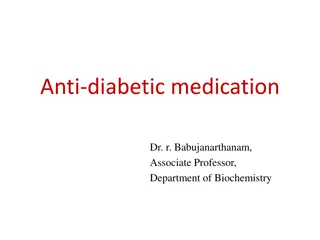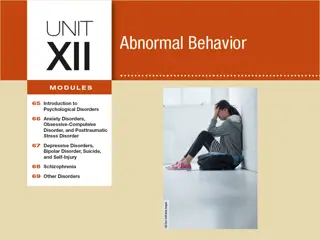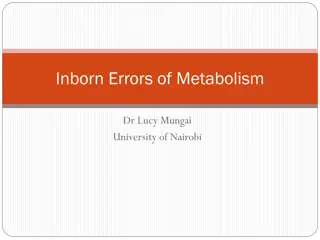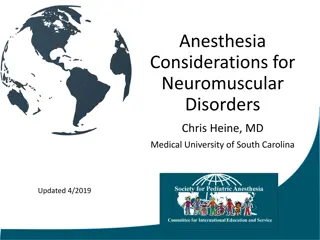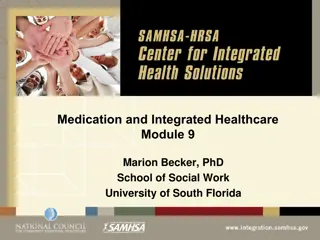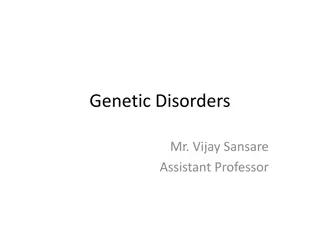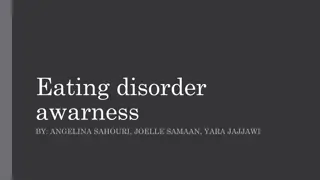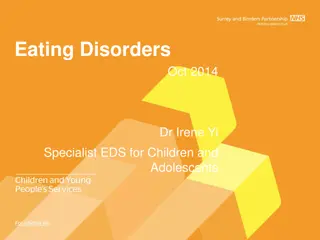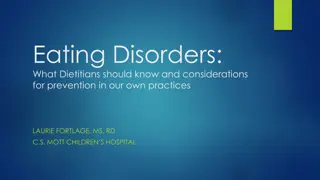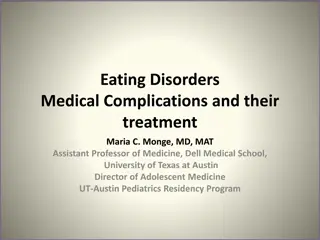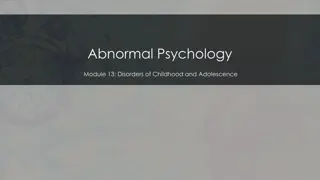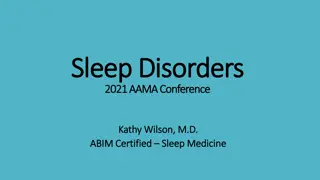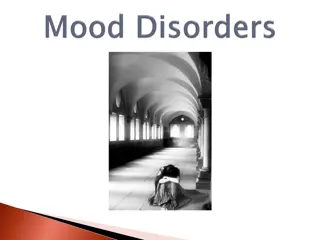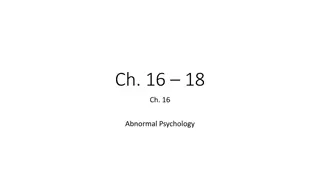Management of Hypoglycemic Disorders: Evaluation and Guidelines
Hypoglycemia can present with various etiologies, including insulinoma, NIPHS, and antibody-related disorders. Diagnosis relies on clinical evaluation and specialized tests. Treatment may involve partial pancreatectomy or exclusion of surreptitious causes. Guidelines emphasize the importance of thorough assessment and targeted management to alleviate hypoglycemic episodes effectively.
Download Presentation

Please find below an Image/Link to download the presentation.
The content on the website is provided AS IS for your information and personal use only. It may not be sold, licensed, or shared on other websites without obtaining consent from the author.If you encounter any issues during the download, it is possible that the publisher has removed the file from their server.
You are allowed to download the files provided on this website for personal or commercial use, subject to the condition that they are used lawfully. All files are the property of their respective owners.
The content on the website is provided AS IS for your information and personal use only. It may not be sold, licensed, or shared on other websites without obtaining consent from the author.
E N D
Presentation Transcript
In the name of GOD
Problem list EPISODIC SEVER HYPOGLYCEMIA HIGH LEVEL OF INSULIN IN HYPOGLYCEMIC EPISODE HIGH LEVEL OF C-PEPTIDE IN HYPOGLYCEMIC EPISODE LONG PERIODS WITHOUT HYPOGLYCEMIA RELAPSE AFTER EVENT-FREE PERIODS OF 3 MONTH AFTER PANCREATIC LESION ENUCLEATION HIGH SERUM GLIBENCLAMIDE LEVEL
Evaluation and Management of Adult Hypoglycemic Disorders: An Endocrine Society Clinical Practice Guideline J Clin Endocrinol Metab, March 2009, 94(3):709 728
The noninsulinoma pancreatogenous hypoglycemia syndrome (NIPHS) The frequency of NIPHS is much less than that of insulinoma. endogenous hyperinsulinemic hypoglycemia typically, but not invariably, after a meal . There is a predominance in men. The pancreatic abnormality is diffuse islet involvement with nesidioblastosis Radiological localization procedures are invariably negative. Confirmation of islet hyperfunction depends on a positive selective arterial calcium stimulation test. Amelioration of symptoms can be expected with partial pancreatectomy guided by the results of the calcium stimulation test.
Hypoglycemia due to the development of antibodies to native insulin is a rare disorder reported to occur primarily among persons of Japanese or Korean ethnicity often have a history of autoimmune disease Symptoms occur in the late postprandial period Clues to the diagnosis include very high measured insulin levels during hypoglycemia.
Factitious hypoglycemia Sulfonylurea consumption produces a biochemical pattern, mimicking insulinoma (inappropriately high plasma levels of insulin and C-peptide) Diagnosis is usually established via exclusion it can be diagnosed with positive drug screening clinical suspicion is the best strategy for diagnosis, due to the lack of any definitive laboratory findings, Surreptitious hypoglycemia is more common in people with knowledge of, and access to, glucose-lowering medications
Methods: In this systematic review, 114 articles with 6222 cases of insulinoma were reviewed with emphasis on localization techniques and surgical treatment
A total of 17 patients were referred to the NIH after a failed blind distal pancreatectomy. Of these, five were diagnosed as having factitious hypoglycemia, and in the remaining patients a tumor was localized in the head.
Hypoglycemia after factitiously self-administered sulfonylurea overdosages has been previously described in 23 cases. Surreptitious sulfonylurea overdosages have led to reports of eight unnecessary laparotomies, including an exploration resulting in postoperative bleeding and death , and five partial pancreatectomies . Evidence of surreptitious sulfonylurea usage was obtained from blood or urine assays in 16 cases , from a room or personal effects search in 6 cases , and from repeated questioning followed by a confession in 1 case. Hypoglycemia Following Inadvertent and Factitious Sulfonylurea Over dosages, diabetes care 1995
Features of patients with hypoglycemia after a factitiously self- administered sulfonylurea overdose included eight adult patients or their spouses with medical jobs seven adult patients with a personal history of a spouse with or a close friend with sulfonylurea-treated diabetes mellitus, two teenage patients with a sulfonylurea-treated diabetic parent or guardian an unusual affect or history of psychiatric disease : seven patients an abrupt onset of symptoms without previous milder symptoms : nine failure to reproduce hypoglycemia by a 24-h fast : three patients The age of the factitious overdose patients 34.7 14.1 years (mean SD), was significantly younger than that of insulinoma patients whose mean age has been reported to be at least 41.7 years , but the age distribution of these two groups overlapped Hypoglycemia Following Inadvertent and Factitious Sulfonylurea Overdosages, diabetes care 1995
the presence of a sulfonylurea-related oral hypoglycemic agent in 129 patients who had unexplained severe hypoglycemia. during a 35-month period were investigated using chromatographic liquid method with UV detection. In 22 patients (17%), a second generation of the sulfonylurea oral hypoglycemic agent was detected: glibenclamide was detected in 19 patients, and gliclazide was detected in 3 patients. The study population comprised 13 women (mean age SD 40 18 years) and 9 men (64 11 years). The plasmatic concentrations are usually superior to the therapeutic ones, and in seven cases, they were five times more, with a maximum of 18 times the therapeutic degrees. All of these patients had only one hypoglycemic agent. Serious Hypoglycemia: Munchausen s Syndrome? Diabetes Care 2001
an ICPR in excess of 1.0 in a hypoglycemic patient argues persuasively for surreptitious or inadvertent insulin administration and against insulinoma (or sulfonylurea ingestion) as the cause of the hypoglycemia.
We report 2 cases of factitious hyperinsulinism leading to partial pancreatectomy. Atypical histories of hypoglycemia were noted in both of our patients: long periods without hypoglycemia, severe hypoglycemic episodes, and relapse after event-free periods of several days after partial pancreatectomy
Int J Endocrinol Metab. 2018 January In the primary evaluations, insulinoma was suspected considering the high plasma concentrations of insulin and C-peptide, besides negative urine and plasma sulfonylureas during hypoglycemic episodes. Considering the normal imaging studies and refractory hypoglycemia to medical therapy, distal pancreatectomy was performed. 5 months later, similar episodes recurred. Further investigations revealed different plasma concentrations of insulin and C-peptide in each hypoglycemic episode.
It is suggested to suspect factitious hypoglycemia in patients with diverse biochemical patterns during different hypoglycemic episodes After psychiatric and forensic pathology confirmation, he was discharged with quetiapine (25 mg/day) and outpatient psychiatric visits. However, four months later, he was found unconsciousin a hotel room and died
Ann Intern Med. 1988 Factitious hypoglycemia due to surreptitious administration of insulin. Diagnosis, treatment, and long-term follow-up. Grunberger G1, Weiner JL, Silverman R, Taylor S, Gorden P. 10 patients with factitious hypoglycemia were followed-up for 15 years, only 3 returned to a productive life and 2 committed suicide
Several methods have been developed for the detection of antidiabetic drugs in the human plasma and urine. Some of these methods include micellar electrokinetic capillary chromatography, highperformance liquid chromatography (HPLC) with ultraviolet detection, HPLC with evaporative light scattering detection and HPLC with charged aerosol detection . The problem with most of these methods is their timeconsuming design and possibility of false positive results it can be seen that high-performance liquid chromatography methods have been used most extensively
For all drugs, assay validation showed good linearity (r2 >0.990) and acceptable imprecision and recovery based on commonly used criteria of acceptance. The mean extraction recoveries were 63% 87% for 5 sulfonylureas but <45% for 3 (carbutamide, chlorpropamide, and tolbutamide). The described assay method allows accurate, rapid identification and quantification of 8 sulfonylureas(glibenclamide, glipizide, gliclazide, glibornuride, glimepiride, carbutamide, chlorpropamide, and tolbutamide) in human plasma and can be used for specific diagnosis of factitious hypoglycemia caused by ingestion of these drugs.
this is the first reported case of surreptitious hypoglycemia secondary to repaglinide The patient underwent a second supervised fast. He remained asymptomatic with normal plasma glucose concentrations Repaglinide serum concentrations were determined with liquid chromatography. Repaglinide was detectable (0.2 ngmL) in six of seven stored specimens obtained by the referring endocrinologist during the hypoglycemic episodes at home.
What should we do for this patient? Refer to psychologist Preventing harmful surgery




